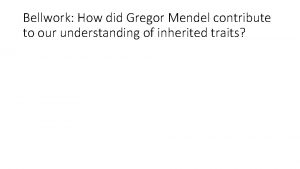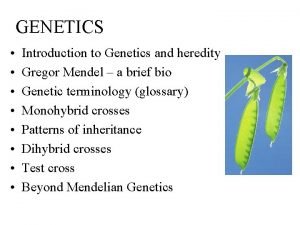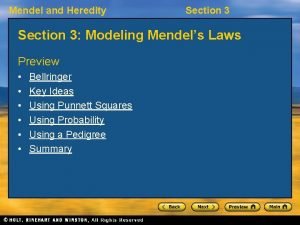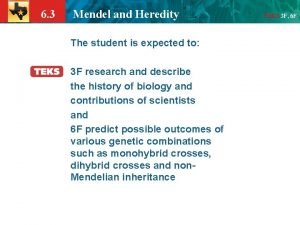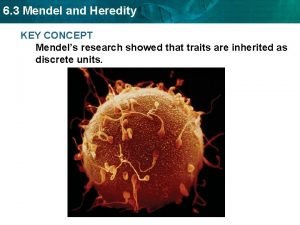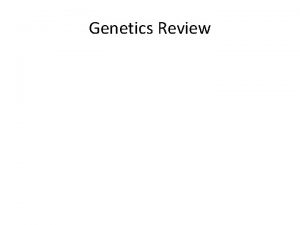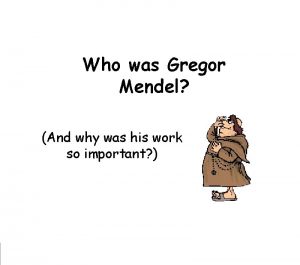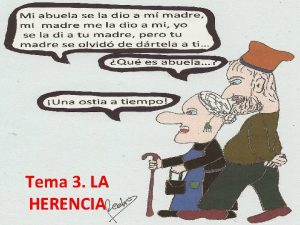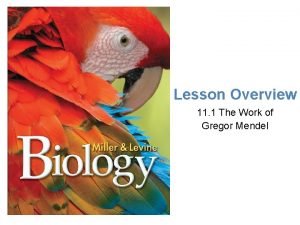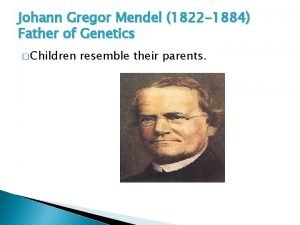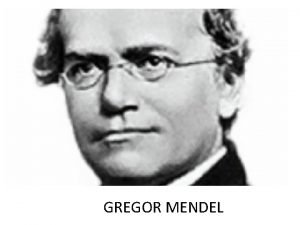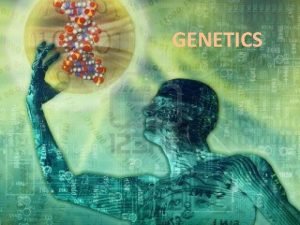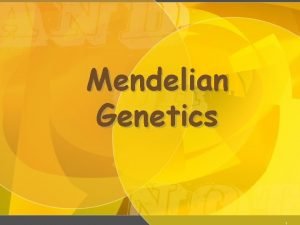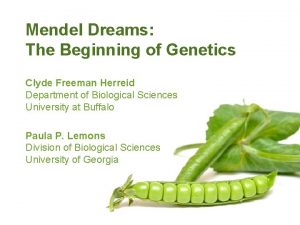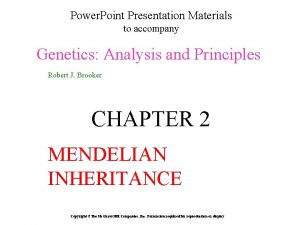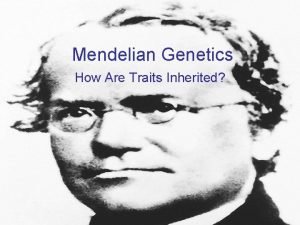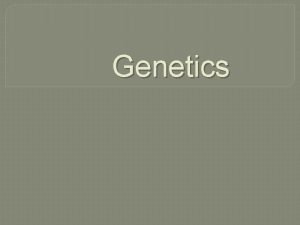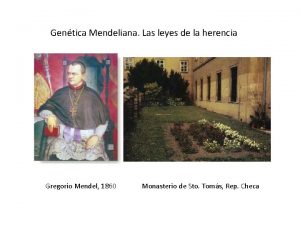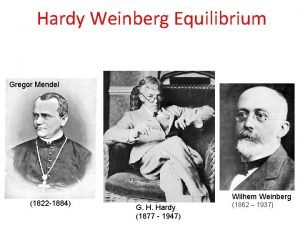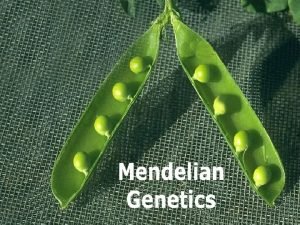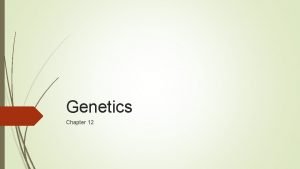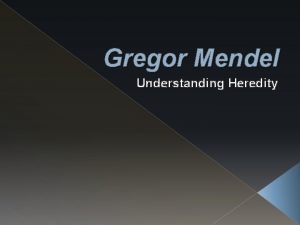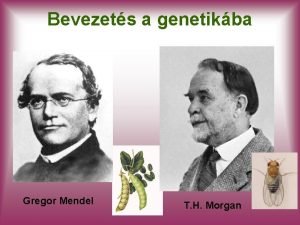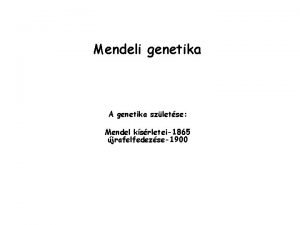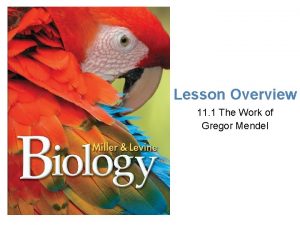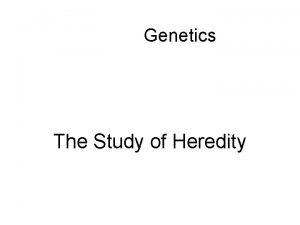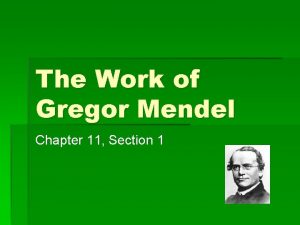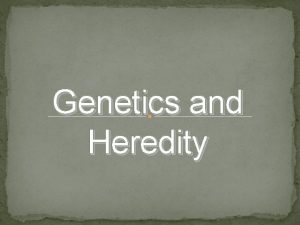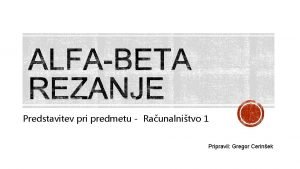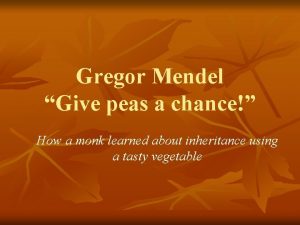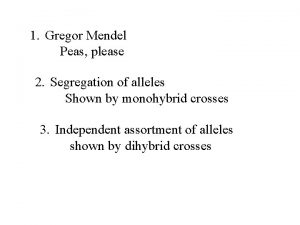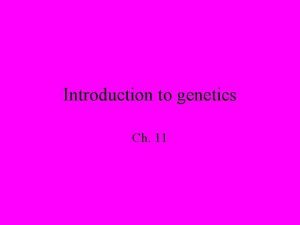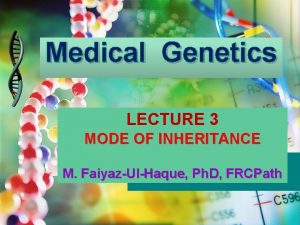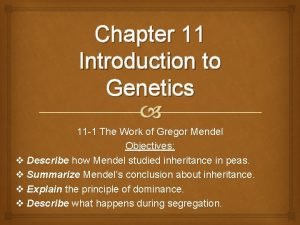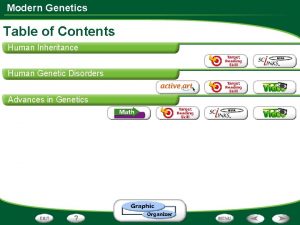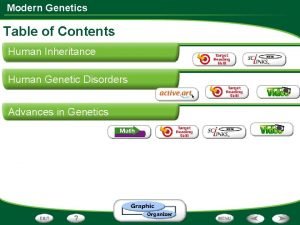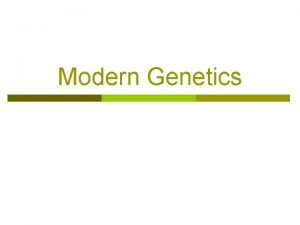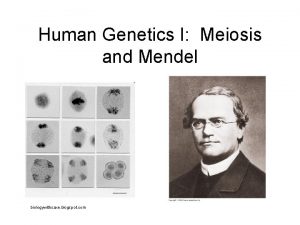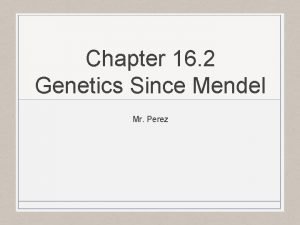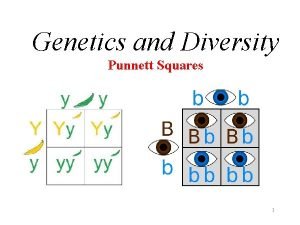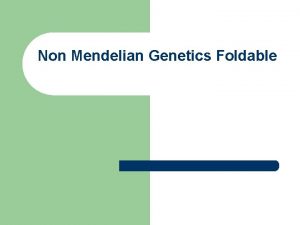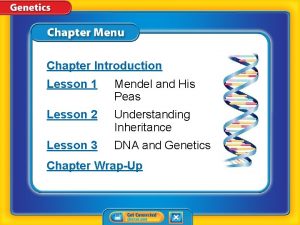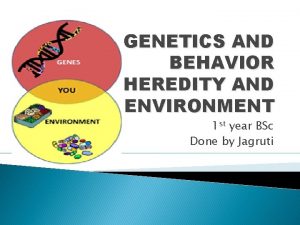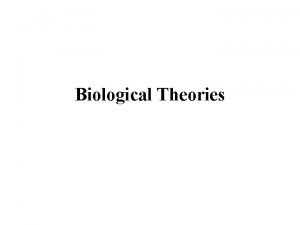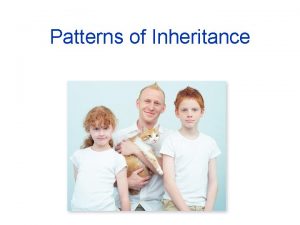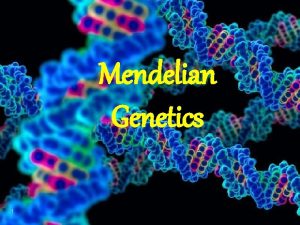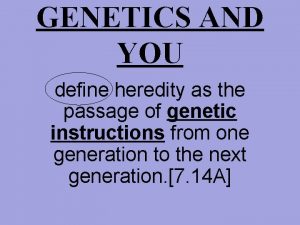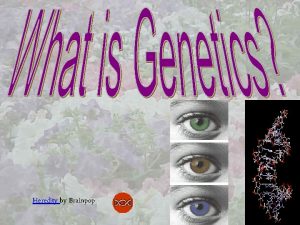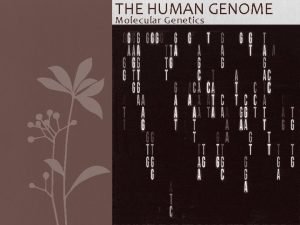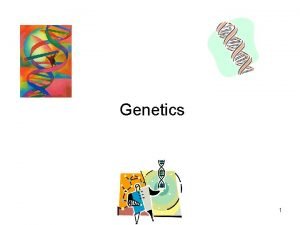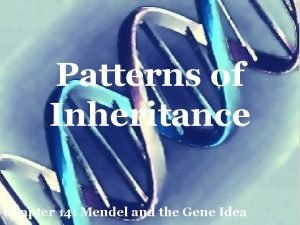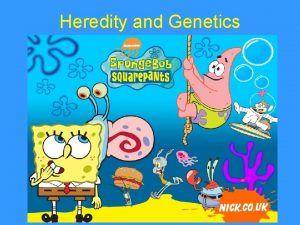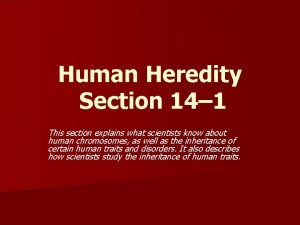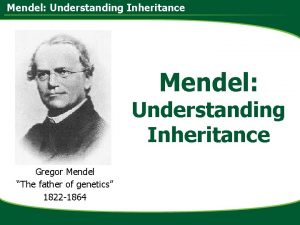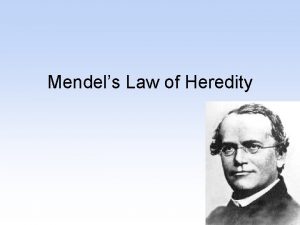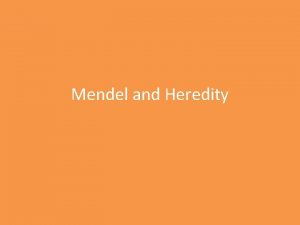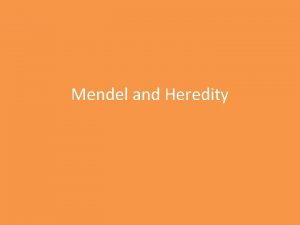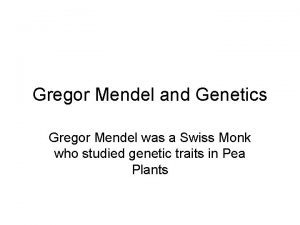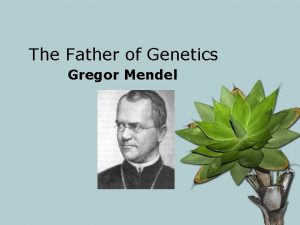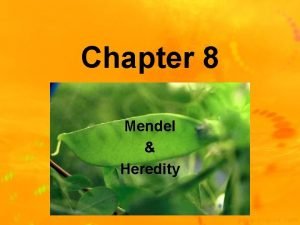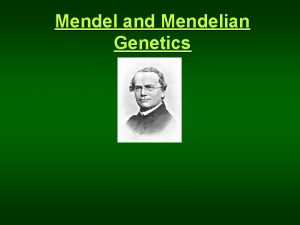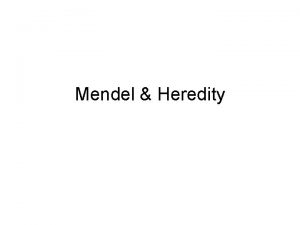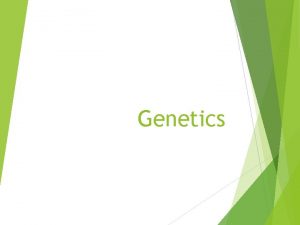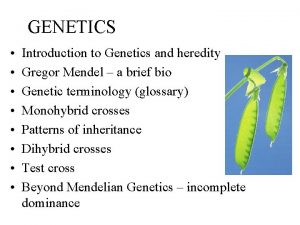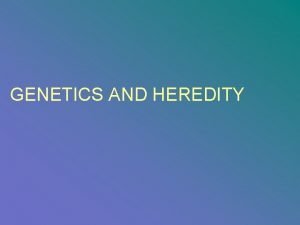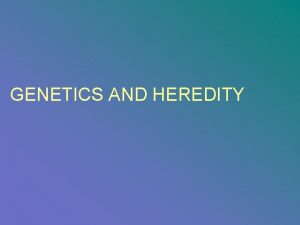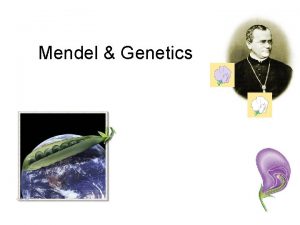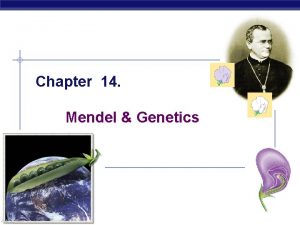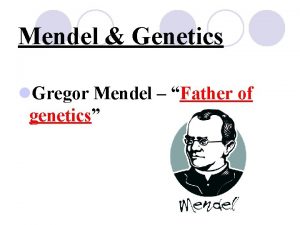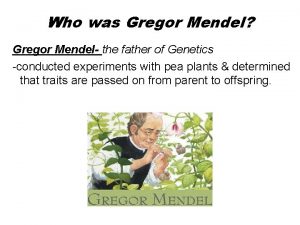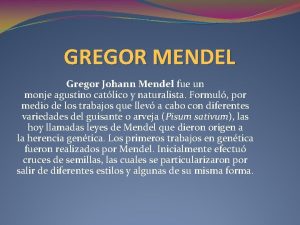Genetics 11 1 Gregor Mendel Heredity Inheritance Genetics



















































































- Slides: 83

Genetics

11. 1 – Gregor Mendel

Heredity ® Inheritance ® Genetics of traits - study of heredity

Genetics Gregor Mendel ® Suggested genes carry inherited traits. ® Predicted how traits were inherited by studying pea plants

The Role of Fertilization - male and female reproductive cells join to produce a new cell.

The Role of Fertilization

The Role of Fertilization • True-breeding plants • • Trait - a specific characteristic • • Produce offspring identical to parent Ex) Seed color and shape. Varies

The Role of Fertilization • Hybrids - Offspring of parents with different traits.

Quick Graded Review – Two Options – 5 minutes v v 1. Stand speak § Summarize the notes in 15 seconds. § Spend the next 3 minutes preparing what you’ll say. 2. Schoology discussion § Go to Schoology your class Unit 7 11. 1 Summary – First Half § Write a summary of the notes so far in at least 3 sentences. § Do not respond to anyone yet.

Genes and Alleles P gen – Parents • F 1 - Offspring of P generation. • In each cross, one parent’s traits seemed to have disappeared.

Genes and Alleles • Characteristics are determined by genes that are passed from parents to offspring.

Dominant and Recessive Traits • Principle of Dominance – Some alleles are dominant, others are recessive. • Express dominant trait if at least one dominant allele is present. • Express recessive trait if no dominant alleles present • Only recessive alleles present.

Alleles ® Different forms of a gene ® Organisms have two alleles for each trait. ® One from egg. ® One from sperm.

Segregation • What happened to the recessive alleles? • F 1 hybrids self-pollinate. • Offspring of F 1 called F 2 generation.

The F 1 Cross • In F 2 plants, recessive traits reappeared. • ¼ of F 2 plants had recessive trait.

Explaining the F 1 Cross • Alleles segregated, or separate, during formation of the sex cells, or gametes.

Seed shape color Flower position Pod color Pod shape purple axial (side) green inflated white terminal (tips) yellow constricted Plant height Dominant trait round yellow tall Recessive trait wrinkled green short

Quick Graded Review – Two Options – 5 minutes v v 1. Stand speak § Summarize this part of notes in 15 seconds. § Spend the next 3 minutes preparing what you’ll say. 2. Schoology discussion § Go to Schoology your class Unit 7 11. 1 Summary – Second Half § Write a summary of this part of notes in at least 3 sentences. § Or respond add on to someone else’s response from First Half with information from notes.

Recessive attached ear lobes Tongue Roll Dominant trait Dominant Free Ear Lobes Hitch hiker’s thumb Dominant Regular thumb Recessive

Other examples Chin cleft – Dominant Bent pinky finger – Dominant Dimples Blue – Dominant eyes – Recessive Hand clasp – Left thumb dominant Widows peak - Dominant

11. 2 – Applying Mendel’s Principles

Dominant gene (allele) ® Stronger gene ® Represented ® Written by capital letter first ® Example: T for tall plant height

Recessive gene (allele) ® Weaker gene ® Hidden if dominant genes present. ® Represented ® Example: with lower case letters t for short plant height

Pure (Homozygous) ® Two of the same genes (alleles) for a trait ® Example: TT (homozygous dominant) or tt (homozygous recessive)

Hybrid (Heterozygous) ® Two different alleles for a trait ® Example: Tt ® Tall or short?

Probability – The likelihood that an event will occur. Example: Flipping a coin Probability 1 of flipping heads? Number of desired outcomes 2 Number of total possible outcomes

Probability Example: Flipping a coin Probability of flipping heads three times? ½ x ½ = 1/8

Genotype ® Combination of alleles for a certain trait ® Example: Tt, TT, tt

Phenotype ® How it physically looks ® Example: tall, short

Genotype or Phenotype? Tt Genotype Round Phenotype Black Phenotype BB Genotype Smooth Phenotype rr Genotype Tall Phenotype

In pea plants, green (G) pods are completely dominant over yellow (g). What are the genotypes? yellow gg Heterozygous green Gg Homozygous dominant GG Hybrid Gg Homozygous

In pea plants, green pods are completely dominant over yellow. Pure gg yellow Homozygous recessive Pure GG green Heterozygous Yellow gg Gg gg

In guinea pigs, short hair is dominant over long hair What hair length will be represented by a capital S? Short What hair length will be represented by a lower case s? Long

What phenotypes would result from the following genotypes? SS Short hair ss Long hair Ss Short hair

Phenotypes of parents? Tall plant If both parents are pure, what are their genotypes? Which allele will each parent pass on to offspring? Phenotype of offspring? Short plant T T t t T t Genotype of offspring? All tall plants T t

In pea plants, round is dominant over wrinkled texture. What is the genotype of the following? homozygous round RR heterozygous Rr rr wrinkled RR pure dominant hybrid round Rr

In pea plants, round is dominant over wrinkled texture. What is the genotype of the following? pure rr recessive Rr heterozygous round pure wrinkled rr hybrid Rr RR pure round

Punnett Squares ® Punnett squares – predict the result from a cross.

Monohybrid crosses Heterozygous tall parent T T t t T TT Tt tt

How To Make a Punnett Square for a One. Factor Cross Write the genotypes of the parents. Ex) Cross a male and female bird that are heterozygous for large beaks. Genotypes of Bb. Bb x Bb

How To Make a Punnett Square Draw a Punnett square. Put one parent on the top, one parent on the left. Put one allele from each parent on each side of each section.

How To Make a Punnett Square Fill in the table by combining the gametes’ genotypes. Mom Dad

How To Make a Punnett Square -Determine the genotypes and phenotypes of each offspring.

Probability of having… A large beak? A small beak? Homozygous 3: 4 1: 4 dominant? 1: 4 Heterozygous? Homozygous recessive? 2: 4 1: 4

Independent Assortment Principle of independent assortment – genes segregate independently. One gene does not effect another. I. e. - Hair color does not effect eye color.

Dihybrid Cross Two factor cross Two traits involved.

The Two-Factor Cross: F 1 Cross two true-breeding plants: One produced only round yellow peas One produced only wrinkled green peas.

The Two-Factor Cross: F 1 -Round yellow peas had genotype RRYY -Homozygous dominant.

The Two-Factor Cross: F 1 -Wrinkled green peas had genotype rryy - Homozygous recessive

The Two-Factor Cross: F 1 All F 1 offspring were round yellow. Shows yellow and round alleles are dominant over green and wrinkled. Punnett square shows genotype of F 1 offspring as Rr. Yy, heterozygous for both seed shape and seed color.

The Two-Factor Cross: F 2 Crossed F 1 plants to produce F 2 offspring. Crossed Rr. Yy with Rr. Yy

Dihybrid cross instructions Cross the parent alleles. Outside has one of each allele has 4 alleles, two from each parent Mom Inside Dad


The Two-Factor Cross: F 2 Different genes do not influence each other’s inheritance.

The Two-Factor Cross: F 2 Dihybrid cross has 9: 3: 3: 1 ratio. Principle of independent assortment – genes for different traits segregate independently.

11. 3 Other Patterns of Inheritance

Incomplete dominance ® Alleles BLEND (mix) ® Neither gene is dominant ® Heterozygous phenotype is a blend. ® Like colors of paint ®Red + White = Pink

Incomplete Dominance r r www. nerdscience. com R R Rr Rr 11 -3

Codominance ® Both alleles are dominant ® Heterozygous expresses both. ® There is NO “blending” ®Red + White = Red and White

® Red cow + white cow = roan cattle. Roan cattle have both red and white hairs. Codominance

Codominance Example: White chicken (WW) x black chicken (BB) = black and white checkered chicken (BW)

Codominance

Incomplete or Codominance? ®A white cow and a red cow produce a roan cow, one that has both white and red hairs. Codominance ®A red flower and a white flower produce pink flowers. Incomplete ®A black cat and a tan cat produce tabby cats, cats where black and tan fur is seen together. Codominance

Incomplete or Codominance? ®A blue blah bird and a white blah bird produce offspring that are silver. Incomplete ®A certain species of mouse with black fur is crossed with a mouse with white fur and all of the offspring have grey fur. Incomplete ®A woman with blood type A and a man with blood type B have a child with blood type AB. Codominance

Multiple Alleles Single gene with more than two alleles. Trait determined by 2 alleles example: type human blood

Blood Types (codominant) ® Blood type is codominant ® IA and IB are dominant. ® i is recessive ® 4 different blood types Phenotype Genotype (Blood (Alleles or type) genes for blood type) A I AI A, I Ai B I BI B, I Bi AB I AI B O ii

Polygenic Traits controlled by many genes Wide range of phenotypes. example: human skin color has four different genes Skin color genes: Aa. Bb. Cc. Dd

Genes and the Environment Genes provide a plan for development, but also depends on the environment. Both nature and nurture

14. 1 – Human Chromosomes

Karyotype ® Chart of chromosome pairs. ® Shows genome – full set of genetic information.

Karyotype Normal Female

Karyotype Female with Down Syndrome

Sex Chromosomes ®X and Y chromosomes ® Determine the sex of the offspring ® Females are XX ® Males are XY

Sex Chromosomes ® All other chromosomes are autosomes. ® Everyone has 46 chromsomes: 2 sex chromosomes and 44 autosomes.

Sex-linked Traits ® Most inherited on X and Y chromosomes. on X chromosome ® Ex) Color blindness recessive sex-linked trait on X-chromosome ® Males show recessive sex-linked traits more than females

Sex-linked Traits ® Heterozygous carriers females are

X-Chromosome Inactivation In female cells, one X chromosome is randomly switched off, forming a Barr body. Not found in males because only have one X chromosome.

Pedigree Study ® Method of determining the genotype of individuals by looking at inheritance patterns

Male Parents Female Siblings Affected male Affected female Mating Known heterozygotes for recessive allele Death Pedigrees illustrate inheritance

Human Pedigrees This diagram shows what the symbols in a pedigree represent.

Human Pedigrees This pedigree shows how one human trait—a white lock of hair just above the forehead— passes through three generations of a family. The allele for the white forelock trait is dominant.

Human Pedigrees Top of the chart is grandfather with the white forelock trait. Two of his three children inherited the trait. Three grandchildren have the trait, but two do not.

Human Pedigrees Because the white forelock trait is dominant, all family members lacking this trait must have homozygous recessive alleles. One of the grandfather’s children lacks the white forelock trait, so the grandfather must be heterozygous for this trait.
 How did gregor mendel contribute to genetics
How did gregor mendel contribute to genetics Gregor mendel a monk
Gregor mendel a monk Chapter 11 biology review answers
Chapter 11 biology review answers Mendel
Mendel Chapter 11 complex inheritance and human heredity test
Chapter 11 complex inheritance and human heredity test Section 3 mendel and heredity
Section 3 mendel and heredity Section 3 mendel and heredity
Section 3 mendel and heredity Section 3 mendel and heredity
Section 3 mendel and heredity Section 3 mendel and heredity
Section 3 mendel and heredity Section 3 mendel and heredity
Section 3 mendel and heredity How many pairs of chromosomes do humans have? *
How many pairs of chromosomes do humans have? * Gregor mendel mbti
Gregor mendel mbti Who is gregor mendel
Who is gregor mendel Gregor mendel
Gregor mendel Gregor mendel laws
Gregor mendel laws Who was mendal
Who was mendal Who is gregor mendel
Who is gregor mendel Gregor mendel guisantes
Gregor mendel guisantes Gregor mendel
Gregor mendel Gregor mendel
Gregor mendel Gregor mendel
Gregor mendel Mendel's law of independent assortment
Mendel's law of independent assortment Conclusion de gregor mendel
Conclusion de gregor mendel Austrian monk
Austrian monk Gregor mendel's dream was to?
Gregor mendel's dream was to? Gregor mendel
Gregor mendel Gregor mendel laws
Gregor mendel laws Gregor mendel
Gregor mendel What did gregor mendel research
What did gregor mendel research Gregor mendel herencia
Gregor mendel herencia Hardy weinberg allele frequency
Hardy weinberg allele frequency Who is gregor mendel and what is he famous for
Who is gregor mendel and what is he famous for Austrian monk
Austrian monk Who is gregor mendel and what did he do?
Who is gregor mendel and what did he do? Chapter 12 lesson 1 the work of gregor mendel
Chapter 12 lesson 1 the work of gregor mendel Gregor mendel
Gregor mendel Gregor mendel chart
Gregor mendel chart Fr gregor mendel
Fr gregor mendel Tesztelő keresztezés
Tesztelő keresztezés Gregor mendel summary
Gregor mendel summary Who is gregor mendel
Who is gregor mendel Chapter 11 the work of gregor mendel
Chapter 11 the work of gregor mendel Section 11-1 the work of gregor mendel
Section 11-1 the work of gregor mendel What is the phenotype of a chicken with the genotype fbfw
What is the phenotype of a chicken with the genotype fbfw Mendel traits
Mendel traits Gregor mendel referat
Gregor mendel referat Gregor mendel punnett square
Gregor mendel punnett square Chapter 12 lesson 1 the work of gregor mendel
Chapter 12 lesson 1 the work of gregor mendel Gregor johann mendel
Gregor johann mendel Gregor mendel
Gregor mendel Al cruzar una planta de guisantes de flores purpura
Al cruzar una planta de guisantes de flores purpura Js bach lebenslauf
Js bach lebenslauf Genes is the study of heredity and variation
Genes is the study of heredity and variation Chapter 17 the beginning of the life cycle
Chapter 17 the beginning of the life cycle Mendel's first and second law of inheritance
Mendel's first and second law of inheritance Mendel's 3rd law of inheritance
Mendel's 3rd law of inheritance What is the punnet square
What is the punnet square What did mendel conclude determines biological inheritance
What did mendel conclude determines biological inheritance Who was mendal
Who was mendal What are mendel's three laws of inheritance
What are mendel's three laws of inheritance In the punnett square shown in figure 11-1
In the punnett square shown in figure 11-1 Human inheritance modern genetics answer key
Human inheritance modern genetics answer key Human clone
Human clone Modern genetics human inheritance answer key
Modern genetics human inheritance answer key Do sister chromatids separate in meiosis
Do sister chromatids separate in meiosis Genetics since mendel
Genetics since mendel Blue eye phenotype
Blue eye phenotype Mendel's genetics foldable
Mendel's genetics foldable Altura de andrew garfield
Altura de andrew garfield Heredity
Heredity Heredity and crime
Heredity and crime Early ideas about heredity
Early ideas about heredity When do alleles segregate during meiosis
When do alleles segregate during meiosis Mendelian genetics concept map
Mendelian genetics concept map Heredity is the passage of
Heredity is the passage of A gene carries the ________ for a trait. brainpop
A gene carries the ________ for a trait. brainpop Heredity
Heredity Chapter 11 human heredity section 11-3
Chapter 11 human heredity section 11-3 Heredity acrostic
Heredity acrostic 45 chromosomes
45 chromosomes Dice and coin
Dice and coin The basic units of heredity
The basic units of heredity Heredity examples
Heredity examples Section 14-1 human heredity
Section 14-1 human heredity
